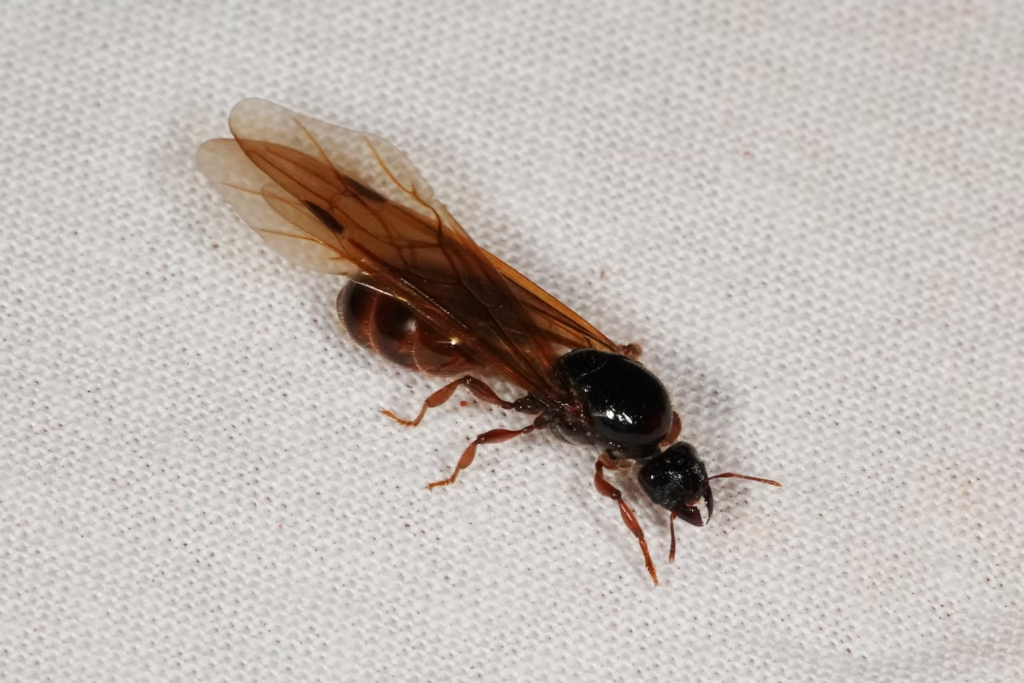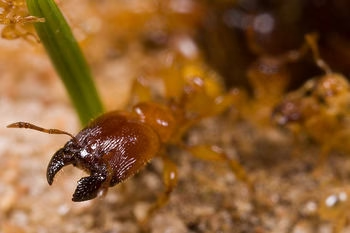| Scientific Name | Pheidole antipodum |
| Common Name | Big-Headed Ant |
| Size | Workers: 2–4 mm | Soldiers (majors): ~4–5 mm | Queens: 8–9 mm |
| Lifespan | Queens ~5 years | Workers ~1 year |
| Colony Type | Monogynous (Single Queen) |
| Foraging Activity | Nocturnal & Crepuscular (active at dawn & dusk) |
| Natural Habitat | Dry regions of Australia; open soil and under rocks |
| Diet | Likely termite predators; may process seeds opportunistically |
| Nuptial Flights | Late spring–early summer (Nov–Dec), evenings |
| Hibernation | No true hibernation; reduced winter activity |
| Founding Style | Fully claustral (queen doesn’t need feeding while founding) |

1. Introduction to Big-Headed Ants
Big-Headed Ant care is rewarding for keepers who enjoy a species with striking worker dimorphism and nocturnal activity. The Big-Headed Ant (Pheidole antipodum) is one of Australia’s most unusual native ants, best known for its minor workers and large-headed soldiers (majors).
Unlike their invasive cousin Pheidole megacephala, this species doesn’t form super colonies, making it more manageable in captivity. Their majors use their oversized heads to break open prey—likely termites—and to defend the nest, giving them a fascinating role in their underground society.
2. Natural Habitat and Distribution
Big-Headed Ants are found across drier parts of mainland Australia, including:
- New South Wales – Inland bushlands and dry forests
- Queensland – Semi-arid grasslands and savannahs
- South Australia – Mallee scrub and drier coastal regions
- Western Australia – Sandy plains and eucalyptus woodlands
Nesting Preferences:
- Subterranean nests – underground chambers with multiple storage areas
- Soil composition – prefers dry, loose soil for easy excavation
- Prey access – often found in areas rich with termite activity
📖 External Resource: For scientific details on Pheidole antipodum, see the AntWiki profile.
🔗 Related Guide: How to Find Queen Ants in Australia
3. Nuptial Flights – When and Where to Catch a Queen
Catching a Big-Headed Ant queen requires patience—almost like trying to nab the last sausage roll at a family gathering.
When Do They Fly?
- Peak Season: Late spring to early summer (November–December)
- Weather Conditions: Warm, humid nights after rainfall
- Time of Day: Evening to early night (6 PM – 10 PM)
How to Identify a Queen:
- Larger size – 8–9 mm, much bigger than workers
- Thicker thorax – due to wing muscles
- Solitary behaviour – mated queens roam alone looking for a nest site
🔗 Related Guide: What to Do with a Queen Ant After Capture
4. Founding Stage – Test Tube Setup
Big-Headed Ant queens are fully claustral, meaning they don’t require food while founding.
Test Tube Setup for Founding:
- Tube size: 16–20 mm, glass or plastic
- Water reservoir: One-third full, sealed with cotton
- Cotton plug: For airflow and escape prevention
- Storage: Keep dark and undisturbed at 24–28 °C
When to Move Them:
- Transfer once the colony reaches 20–30 workers
🔗 Related Guide: The Perfect Test Tube Setup for Queen Ants
5. Big-Headed Ant Care – Housing & Nesting Requirements
Once your colony reaches 20+ workers, it’s time to move them into a secure formicarium.
Best Nest Types:
- Acrylic nests – great visibility and easy to clean
- 3D-printed nests – customisable and expandable
- Ytong (aerated concrete) nests – retain moisture, ideal in dry climates
- Naturalistic setups – soil for digging, mimicking wild behaviour
🚨 Warning: These ants are tiny and quick. Escape-proofing with PTFE barriers and tight lids is essential for long-term Big-Headed Ant care.
🔗 Related Guide: Moving Your Queen Ant to a Formicarium
6. Big-Headed Ant Care – Feeding & Diet
Big-Headed Ants are likely specialised termite predators but will also accept sugars and proteins in captivity.
Best Foods:
- Proteins: Small insects (mealworms, crickets, termites)
- Sugars: Honey water, sugar water, soft fruits
- Seeds: Some colonies process and store seeds opportunistically
Feeding Frequency:
- Remove leftovers to prevent mould
- Offer food every 2–3 days
🔗 Related Guide: The Ultimate Ant Feeding Guide
7. Seasonal Dormancy & Hibernation
Pheidole antipodum doesn’t truly hibernate but slows activity during colder months.
- Feeding: Reduce feeding, but always supply fresh water
- Dormancy Period: May–August
- Temperature: Keep around 18–20 °C
8. Common Problems & Troubleshooting
Problem: Queen Isn’t Laying Eggs
🚨 Possible Causes:
- Too much disturbance – only check every 1–2 weeks
- Temperature too low – keep at 24–28 °C
- Infertile queen – if only male eggs appear, she did not mate successfully
🔗 Related Guide: How to Keep Your Ants Safe from Mites and Pests
Final Thoughts
Big-Headed Ants (Pheidole antipodum) are a fascinating choice for ant keepers who want something different from the usual sugar-hunters. With their dimorphic worker caste, termite-hunting behaviour, and manageable colony size, they’re as educational as they are entertaining.
That said, their tiny size makes escape-proofing vital. With a secure setup and patience, Big-Headed Ant care is both rewarding and full of character.
🐜 Would you keep Big-Headed Ants? Let us know in the comments!

